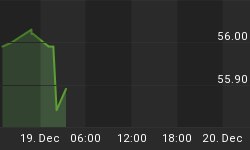A "death cross" is when the 50-day moving average crosses below the 200-day moving average. One just occurred on the S&P 500 Index.

The slang term tells you it is not considered to be a bullish signal. In a July 4, 2010 article Stocks May Surprise By Year End, we wrote:
The "Death Cross" Is Not So Deadly: The "death cross" formation historically has resulted in a 0.4% drop in the S&P the month after, but the market traditionally gains nearly 5% in the ensuing six months, according to a Wall Street Journal report Thursday. A 5% gain in six months is hardly "deadly". We agree a "death cross" is not a good thing, and it does indicate a weakening market. However, all technical systems need to be viewed in the light of how the market performed after a signal occurred. A "death cross" is concerning and should be respected, but it does not mean the end of civilization as we know it.
The S&P 500 gained 34% after our July 2010 comments above, so the death cross under those circumstanced did indeed prove not to be deadly. Unfortunately, the odds of the recent death cross being deadly for stock is greater now than it was last summer.
We studied market history going back to 1930 looking for death crosses that occurred under these basic conditions (similar to what we have today):
- When the 50-day crossed the 200-day, the 200-day was flat or nearly flat.
- The death cross occurred after a substantial and prolonged rise in stock prices.
- Prior to the death cross, the slope of the 200-day moving average, for the most part, had been positive looking back several months to more than a year.
Our study looked at the Dow Jones Industrial Average from 1930 to 1956. From 1957 to 2011, we studied the S&P 500 Index. We found sixteen death crosses between 1930 and 2011 that met the basic criteria above (see table below).

We calculated the risk-reward ratios for stocks following the death crosses above. The table below shows what we should care about: (a) percent of time stocks gained, (b) percent of time stocks lost money, (c) the average gain, (d) the average loss, (e) the risk-adjusted gain, (f) the risk-adjusted loss, and (g) the risk-reward ratio for being invested following similar death crosses in the past.

The term risk-reward implies that even in these historical cases, there were instances where stocks made money after the death cross, but the odds of success are lower than the odds of failure. Our analysis from July 13, Gold and Silver Picking Up Steam Relative to Stocks, aligns well with the recent death cross and less than favorable odds for stocks. Since July 13, stocks have significantly underperformed gold (see SPY relative to GLD below).

In recent weeks, we have been selling stocks (SPY, IYT) and adding to our precious metals positions. Given the recent breakdowns in stocks, we like gold (GLD) better than silver (SLV). We still like silver, but we will be watching it more closely than gold. We will err on the side of holding our gold.
For those who may have missed it, we are again presenting the video below, which covers:
- The current technical backdrop in the context of bull and bear markets.
- CCM Market Models: How they have helped us in the past and what are they telling us now?
- Possible strategies based on bullish or bearish outcomes.
- Fundamentally, why did the markets sell off so rapidly?
- Weak Economy
- Limited options for government further stimulus
- Waning confidence in central bankers
The video above covers the type of information we might discuss over the phone or in a meeting with a client. It is presented here for informational purposes only and does not represent investment advice.
















